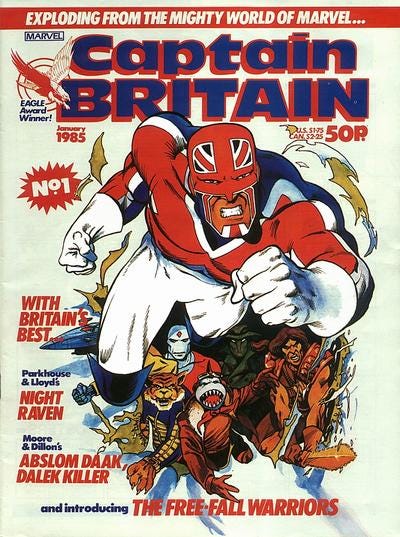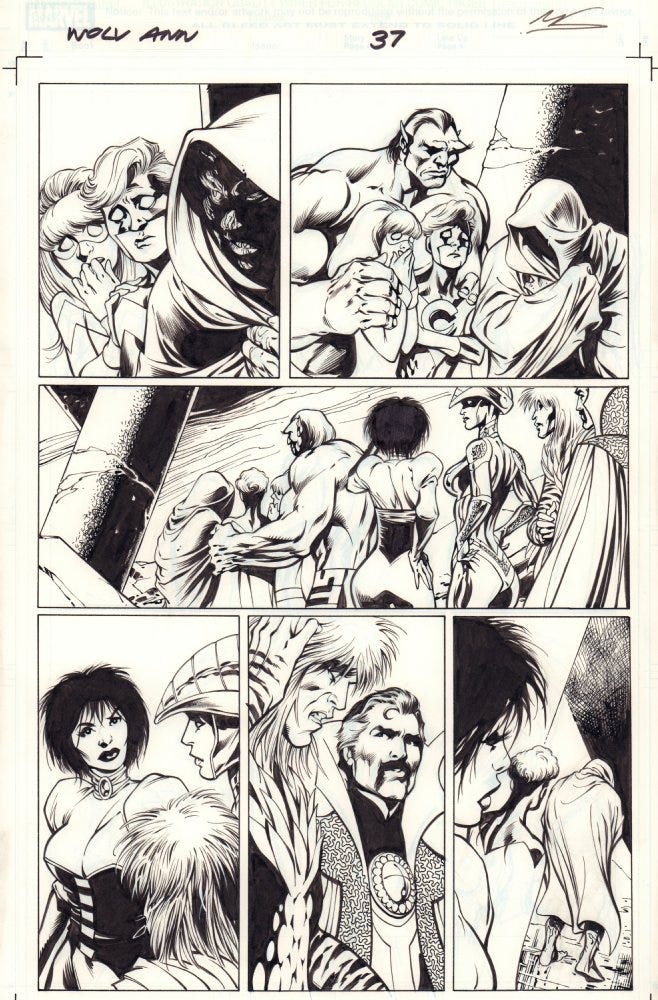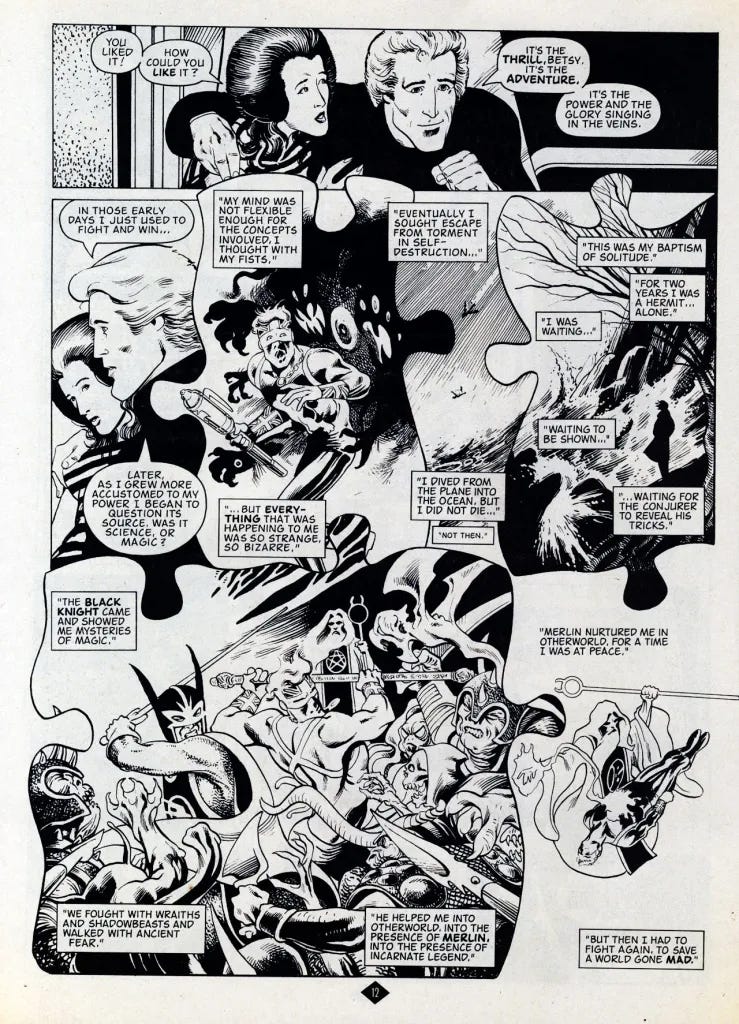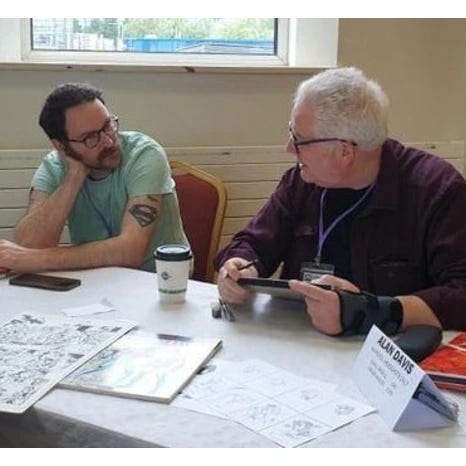Meeting Alan Davis
Wherein I get misty-eyed again about the work of one of my favourite cartoonists
I never met Gustave Flaubert, mostly because he died 94 years before I was born, so I never got the chance for him to tell me in person, 'Il ne faut pas toucher aux idoles: la dorure en reste aux mains'. It means, ‘Don’t touch your idols, a little gold always rubs off’, or as it’s more commonly said, ‘Never meet your heroes’. In my experience, this is pish.
Last year at Enniskillen Comics Festival I got to meet one of my heroes, Alan Davis. He is one of the best cartoonists to come out of the ‘80s, which is quite possibly the most fertile period in comics history. He drew Captain Britain, Miracle Man, Harry 20 on the High Rock, D.R. & Quinch, X-Men, Excalibur, Detective Comics, Batman and the Outsiders, ClanDestine, Fantastic Four, The Nail… and a whole lot more.

The reason I went to Enniskillen was that I was turning 50 in May and I wanted to get a sketch from Alan Davis and maybe say thanks to him for inspiring me to make my own comics. I should also say at this point that I almost never made comics at all because of Alan Davis.
I vividly remember reading Excalibur Special Edition 1 and then bursting into tears, really sobbing, because I knew I could never draw that well. I was crushed as it was still my life goal to draw comics for a living at that point in time. I can feel a lump in my chest when I think about this. It would take me 30 years to realise that I didn’t have to draw as well as Alan Davis to make the best comics I could make - I just had to draw the best that I could draw. It’s seems so obvious, but so many comic artists and cartoonists that I know are sometimes crippled (not literally) by a periodic loss of confidence. My trick is to balance that black cloud with the sheer joy of making comics. ‘Même la nuit la plus sombre prendra fin, et le soleil se lèvera’, as Victor Hugo once wrote. ( I confess here that my French is pure dogshit and I’m just going for a really cultured vibe in this newsletter. I hope it’s working.)
I can see in my own drawing a lot of Davis’ influence, which is unsurprising as for example, I learned to draw women’s bums from reverse-engineering his construction. (I really struggled with the female form until it finally sunk in about modifying the hourglass shape and loosening my wrist.) I also draw bird’s-eye figure shots based on his approach. The original character designs for Big Cat and the Mighty Scotsman owe a lot to the muscular neck and shoulders that Davis drew on Captain Britain and Batman (and he was pulling on Frank Bellamy and Jim Aparo1). I’ve talked about Alan Davis and his influence on the way I draw comics on a couple of podcasts, Mega City Book Club and The Epic Marvel Podcast.
I was pretty nervous about meeting him as his work has had such a huge impact on my life. I wanted to draw exactly like him when I was growing up and I spent countless hours copying his drawings. (Hence the women’s bums.) I’ve met a few famous folk2, but I was genuinely starstruck meeting him.
It turns out that he and his wife Heather are lovely people. He ended up speaking with me for about an hour and a half, which was delightful and surreal. We shared childhood stories of reading comics - including the amusing story of me shitting on the front cover of the first comic of his that I read, Marvel Superheroes 380, when I was 7 years old. Luckily, he found the story funny and signed my replacement copy. He also asked to look through The United: Going Underground, which was utterly nerve-wracking.
I also got to watch him draw and I was surprised at how loosely he approached his under-drawing, it was pretty similar to John Buscema’s approach3, and then tightened up his sketch. He drew Nightcrawler and Captain Britain while I sat next to him and I learned so much from watching him. You can learn a lot from looking at a published comic page and you can learn even more from studying the original art - but you learn most of all from watching a comic artist or cartoonist draw. It’s one of the happiest memories of my life and my wife was nearly crying when I called her immediately afterwards as she could hear how much it meant to me, and she’s usually a heartless cow.
Special thanks again to Patrick O’Connor and David Morris of Time Bomb Comics for introducing me to Alan and Heather. I still smile thinking about it. I plan to visit Enniskillen Comics Festival once I have finished my work-in-progress comic, The United: Five Triangles.
Studying Alan Davis’ Work
Davis notes in Modern Masters Volume One that his work has been shaped by numerous British and American influences. Some of these influences are very apparent in his style and I think that Frank Bellamy, Neal Adams, Jim Aparo, John Buscema and Gil Kane are probably most obvious with regards to construction, style and the way that Davis manipulates the human form. His figure-work is incredibly dynamic and he’s also great at capturing small gestures. He is often credited for drawing beautiful people - and he does - but he also draws a variety of body types. Captain Britain has a very, very different physique to Nightcrawler, for example. Meggan, Phoenix and Shadow Cat all have different body shapes4. It’s the way he draws people standing that gets me every time and this is where part of his Steve Ditko influence comes in. Ditko was great at those small gestures and body language, truly great. Among his other influences are Frank Hampson, Don Lawrence, Gerry Haylock, Solano Lopez, Leo Baxendale (hence the absurdity of the Crazy Gang and Gatecrasher’s Technet?), Jesus Blasco, Syd Jordan, John M. Burns, Nestor Redondo and Barry Windsor-Smith.

I’m not surprised to see quite a few naturalistic comic artists in there as Davis has an illustrative polish that sits wonderfully on top of his cartooning. I think that high-level technique, and his brilliant composition and storytelling, that make him such a great cover artist too.
Most of all, as much as I love his style - and I LOVE his style - it’s his storytelling that impresses me the most. It’s super-solid and he knows how to pace a story perfectly. He has excellent instincts and I suspect that’s why he particularly likes working in the Marvel Method.
Alan Davis’ website is a treasure trove of his art and there are numerous sections about his approach to making comics, as well as commentary on other comic artists, such as Frank Bellamy. It’s a great resource and can be found here. I’ve purposely provided the link to Alan’s pages on process, which are incredibly insightful. The Alan Davis Forum is also a great place to visit and this can be found here.

See Modern Masters Volume One: Alan Davis, edited by Eric Nolen-Weathington. The Modern Masters series from TwoMorrows is great.
I met Prince in a Manhattan nightclub about 25 years ago and accidentally pissed on Gaz Coombes from Supergrass in my early 20s.
See How to Draw Comics the Marvel Way, by John Buscema with Stan Lee. (yes, I realise what the published credit is and I don’t care - Buscema is the primary author.)
I do this by studying the different body shapes and heights of professional boxers. For instance, I would draw Spider-Man with a light-middleweight physique whilst Batman would be more in line with a modern heavyweight, like Vladimir Klitschko.





Lovely article. I suspect you also made his day, too. Conventions are such weird events, all human life is there. But I often enjoy the simple fact that people are meeting their absolute HEROES. It’s heady stuff.
Another comics giant -- and one of my faves. I've not met him, but I did interview him for BACK ISSUE magazine many years ago. His work on Marvelman and Captain Britain were real eye-openers for young me back in the early-80s, and I followed his career when he went to DC (Batman & the Outsiders) and then Marvel, for his magnificent Excalibur runs and so much else. Recently reread his JLA: Nail series, and they're so great!